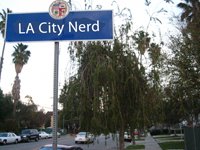So, how did those 5 numbers become so famous, and how did they get to be ordered in that way for that part of the City?
The reason for ZIP codes is efficiency in mail delivery. This was an issue in Los Angeles as far back as 1882 when the Times called for a renumbering of the street numbers because of the volume of mail being delivered in the booming cowtown. They proposed a system that we use today: starting at Main & First and counting 100 numbers per block. That was the first change to help the mail go through.
Flash forward to 1963, the former 2-digit "Zone Code" implemented in the first part of the 20th century was converted to a 5-digit code: the first 3 digits being the larger city code, and the last 2 digits were the original zone codes that had been utilized for decades. The implementation was voluntary in 1963 and became mandatory in 1967. This was the introduction of the modern day ZIP code (ZIP is an acronym for "Zone Improvement Plan" and therefore always capitalized.) It was done to process the large volumes of mail - specifically direct mail - being sent through the US Postal Service. Today, there are also an addition four digits that give even more specificity to the location of the addressee. Here's the current breakdown:
The nine digits of a ZIP+4 code (e.g., 12345-6789) may be grouped as follows:[123] [45] – [67] [89]
[123] : Sectional Center or Large City
[45] : Post Office™ facility or Delivery Area
– : The required "dash" or "hyphen" separates the first 5 digits from the last 4 digits
[67] : Sector or Several Blocks
[89] : Segment or One Side of a Street
So, that's where our famous ZIP codes came from locally. All Los Angeles ZIP codes start with a 9, and then it goes all over the place from there. Remember when searching for "Los Angeles ZIP codes," the City includes more than just the 90XXX ZIP codes. There's a great City of Los Angeles ZIP code map fro the entire City on this page.


4 comments:
As an example of "the last 2 digits [being] the original zone codes that had been utilized for decades" -
I have an old rubber address stamp for a business in Pico Union. It reads "Los Angeles 6, California".
The zone code 6 was replaced by ZIP code 90006.
Ah zip codes, one of my favorite nerdinesses. It's interesting to see how the 3-codes (i.e., the first three digits of the zip).
As you noted 900xx is LA "proper", but you can see some of the history of the city's annexation in some of the non-900xx codes in L.A., 913 and 914 are the San Fernando Valley, 904 covers the coast, 917 the San Gabriel valley.
It's worth noting that in the +4 codes, there are some which get to great specificity. If you get a P.O. Box, for example, your zip+4 will be unique to that box (likewise, zip+4 codes for business reply mail are specific to the return address and account). In many cases, a zip+4 will be specific to a single apartment/condo/office building, and places like Mailboxes Etc get their own zip+4 codes as well.
Publication 100 of the USPS has a "ZIP Code" section. The first number in the ZIP Code "designated a broad geographical area of the United States, ranging from zero for the Northeast to nine for the far West". It was the next two numbers which narrowed it down a bit to a region which was "accessible to common transportation networks". Also, according the page, ZIP stands for "Zoning Improvement Plan".
My 90026 backyard has turned into a surprising repository of much odd and random stuff unearthed (from a World War II German army helmet to 40-plus-year-old whisky bottles). One of the things I dug up last December was a stamped mailing label plate that sported only a "26" and I first thought the missing "900" was simply for space reasons until I did some research and found out out the postal zone numbers that predated the ZIP system, making this relic at least 43 years old.
Post a Comment